The plant Proserpinaca Palustris sometimes also known as Mermaid Weed is a common aquatic plant that is well spread out in the South Eastern United States as well as South America. The plant is known to grow in wetlands although it grows in variety of conditions due to its tolerant nature to varying conditions. The plant usually exhibits a variety of characteristics in the way it looks and grows. The plant has grown into a wide range of varieties that are dependent on the region it grows in. It is a good aquatic plant even for the beginners in the hobby because it easily adapts to changing conditions.
Due to its striking look, Proserpinaca Palutstris, often known as Mermaid Weed, is among the most beautiful freshwater plants. The leaves of this unusual plant begin green and then turn a reddish-pink color!
Furthermore, the texture and shape of your fish alter with the lighting in the tank. Mermaid Weed, which can grow from about 4 to 16 inches tall and 2 to 6 inches broad, will turn heads in your aquarium.
As great as Mermaid Weed, it is recommended to wait until you’re a little more skilled before trying to grow such plants if you’re a beginner enthusiast. Because of its propensity for heavy shedding, keeping the lighting and water conditions under control is critical. If you’re just getting started in the aquarium hobby, it’s probably best to concentrate on the very fish first and then move on to the plants.
The plant is considered by many as one of the most beautiful freshwater aquarium plants owing to its leaves that look intricate and the vivid coloration the plant exhibits.
It can be grown as a freshwater aquarium plant to help give the aquarium a great look. It is one plant that if given the right growing conditions will help make a great addition to your aquarium owing to the beauty that its leaves usually exude. When grown in an aquarium setting, it is best to offer it sufficient carbon dioxide supplementation. The plant isn’t so demanding therefore as a beginner you can actually take it home to grow it in your own aquarium.
Table of Contents
Proserpinaca Palustris: A Quick Summary
Proserpinaca palustris is an aquatic plant native to North America used in herbal medicine and as a natural water purifier. It has purple or pink stems and small white flowers and grows in marshes, swamps, and other wetland habitats.
Proserpinaca Palustris Overview
Proserpinaca Palustris can be seen in North and South America’s wetlands and the Caribbean.
You’ll probably encounter them in Rhode Island, New Hampshire, Massachusetts, Connecticut, Maine, and Vermont if you’re in the northeastern United States.
Since the 1950s, various kinds of this herbaceous plant have been imported from Cuba for use in aquariums and ponds.
It is normally found half-submerged in the wild, but it will most likely be entirely immersed in your home aquarium. It can survive in either situation.
| Information Chart | Proserpinaca, Palustris |
|---|---|
| Scientific Name: | If any, else skip |
| Family: | Haloragaceae |
| Care Level: | Moderate to difficult |
| Growth Rate: | Intermediate |
| Maximum Size: | 4 to 16 inches |
| Minimum Tank Size: | 10 gallons |
| Water Conditions: | 5-7.5 ph 50 to 82 ° F |
| Lighting: | Bright |
| Propagation: | Cuttings |
| Placement: | Background or midground |
Appearance of Proserpinaca Palustris
The plant has got an overall beautiful appearance and can make a great addition to your aquarium. The plant features leaves that look saw-toothed when growing freely in the wild but when grown in an aquarium setting will slowly grow leaves that are long and look needle-like in shape. The plant usually turns to look stunningly beautiful when grown under good lighting conditions. It is known to turn to copper coloration with sufficient lighting offered to it. Basically the various species of the plant are known to exhibit varied leaf appearance. The leaves of the submersed plant usually grow to between 5 to 10 centimeters long. They are also usually feather-like divided although some of the leaves will show hair-like leaflets.

As for the emergent leaves of the plant, the leaves usually show blade-like appearance. This may change as per the region where the plant is growing in.
Mermaid Weed’s appearance varies based on the area in which it grows, the size of the tank, the lighting, and how you prune it in your home aquarium. Thus, it might appear to be a completely different plant in diverse habitats.
Proserpinaca Palustris is a fantastic choice for individuals interested in aquascaping because it is adaptable to your design goals. One of the grounds it has grown so widely across North and South America is that it is extremely adaptive to changing environments.
It is not regarded as an invasive species because it grows slowly. And while it thrives in a wide range of settings, it does necessitate some special considerations in the home aquarium; thus, they are graded Proserpinaca Palustris as moderate-level care plants.
Proserpinaca Palustris Size
The typical Proserpinaca Palustris typically grows up to X inches on the lower end and X inches for larger specimens.
It can grow 4-16 inches tall and 2- 6 inches wide. The leaves are more circular and noticeably green in emergent growth. This plant will keep true to its common phrase and proliferate profusely via seeds in this growth style.
Proserpinaca Palustris Native Habitation and Origin
The plant has an overall beautiful appearance and can make a great addition to your aquarium. The plant features leave that look saw-toothed when growing freely in the wild, but when grown in an aquarium setting, it will slowly grow long leaves that look needle-like in shape. The plant usually turns stunningly beautiful when grown under good lighting conditions.
It is known to turn copper-colored under sufficient lighting. The various plant species are known to exhibit varied leaf appearances. The leaves of the submersed plant usually grow to between 5 to 10 centimeters long. They are also usually feather-like, although some of the leaves will show hair-like leaflets.
As for the emergent leaves of the plant, the leaves usually show a blade-like appearance. This may change as per the region where the plant is growing.
Proserpinaca Palustris Care and Tank Set-Up
Because Proserpinaca Palustris grows a bit more slowly than the other aquarium plants, it can be grown in smaller aquariums. You don’t want to go too small because they still require growing room. You can also replace plant clippings as you collect as you prune.
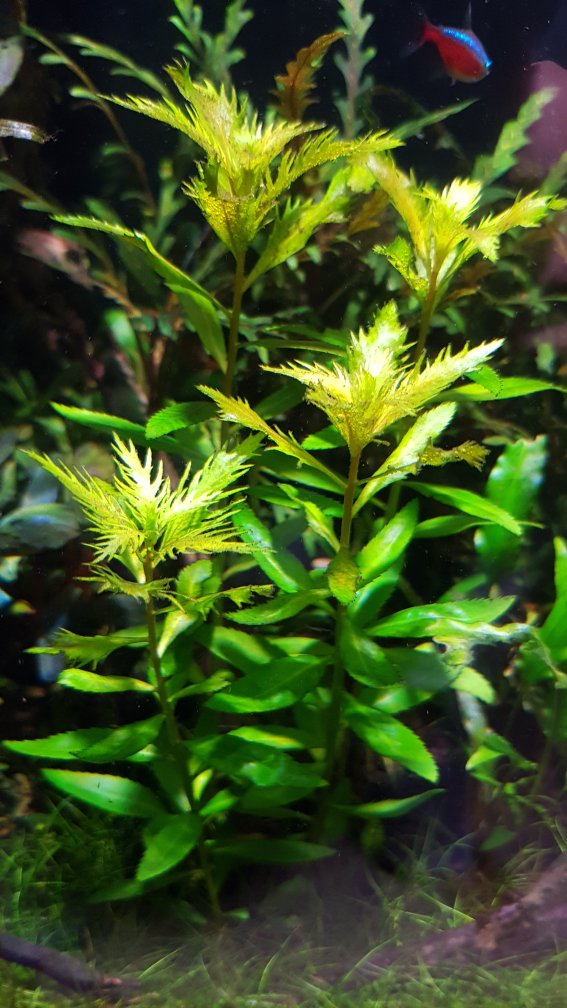
One concern with care is the habit of dropping many leaves in captivity if they don’t get enough nutrients from the water. To keep them healthy, you need to feed them with water fertilizers and inject them with carbon dioxide.
If they lose too many leaves, you’ll have unclean water high in ammonia and nitrate, which is bad for your fish and Mermaid Weed. Plus, you don’t want to detract from the stunning appearance of these plants in your aquarium.
Also, be hesitant to put Proserpinaca Palustris in the tank containing goldfish, as they’ll more likely consume plant-like candy. Mermaid Weed will do the trick for tadpoles, who will eat them and acquire some much-needed nutrients if you need nourishment for the fish.
However, because few water critters are eager to eat Proserpinaca Palustris, you won’t have to worry about the plants being harmed.
Cultivation/propagation
The plant is moderately easy to cultivate and is a good option for beginners who are just getting started in aquarium plant cultivation. It is usually re-grown by way of cuttings which must be done carefully for any success to be achieved. New plants usually grow by way lateral shoots that shot off from the original plant once chopped off from the parent plant. Once the cuttings are obtained, they can be planted by being inserted into the substrate where growth of the plant is desired. With time, the cuttings will slowly grow roots and thus become independent plants in their own right.
Below are some parameters to consider when cultivating Proserpinaca Palustris in an aquarium:
- an aquarium of at least 40 liters
- water pH should be at least 6.7
- lighting should be adequate as the plant does well in environments with lots of light
- substrate can be soil and you can add water fertilizers to help improve growth of the plant
Proserpinaca Palustris Tank Size and Specifications
Proserpinaca Palustris need plenty of bright light to thrive. Carbon dioxide and Water fertilizers additions will help them thrive.
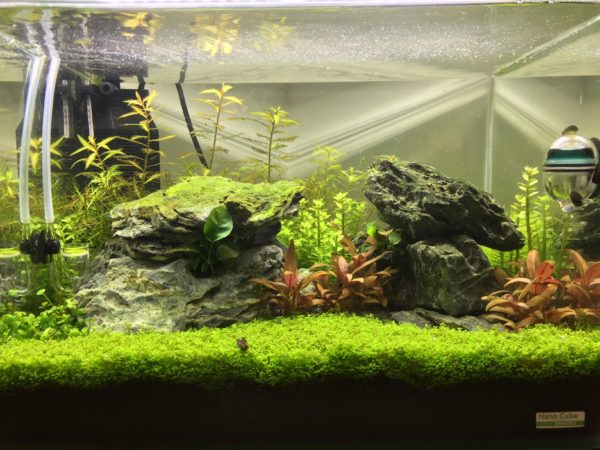
You could not have a filter because you’ll utilize a smaller tank. If you use a filter, make sure it doesn’t make the flow too strong, as the Mermaid Weed prefers motionless or slow-moving water in its native habitat.
Optimum Tank Size for Proserpinaca Palustris
A 10-gallon tank is recommended, although a larger tank is steadier and more hassle-free. Mermaid Weed can reach up to 16 inches tall, but you can keep it in a small tank if you trim it and care for it more frequently.
Substrate
You should plant your Mermaid weed in fine, sandy ground. It is gentler on the roots and will not harm them as much as coarse gravel because it has less surface area to grab with each step.
If your plant is escaping the substrate, however, you can use extra sand or clay to give weight to the bottom of the pond and keep it buried.
Growing Conditions
Proserpinaca Palustris is to be grown in fresh water with fertilizer to help enhance its growth. It grows better in an environment with medium to bright light. Under these light conditions the plant will show its characteristic coloration. Addition of carbon dioxide into the water helps to achieve its full potential growth. Ensure that the nitrates levels in the tank are kept to their lows for better growth of the plant.
It doesn’t grow fast and even with proper supplementation of the necessary nutrients it will grow at a relatively slow pace. This makes it a great addition to small tanks where it can be used as a center of dominance in the middle ground or fore ground of the aquaria.
Water Parameters for Proserpinaca Palustris
Water Temperature
The mermaid weed’s optimal temperature spans 50 to 82 degrees Fahrenheit, making it exceptionally tolerant of temperatures on either end of the spectrum.
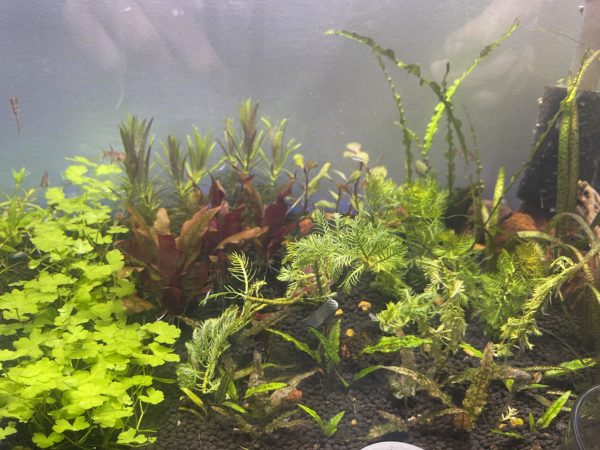
pH Level
Make sure the pH of the water in your tank stays between 5 and 7.5.
Water Hardness
Water hardness should be from very soft to moderate. It should not be hard water because Proserpinaca Palustris cannot survive in it.
Proserpinaca Palustris Tank Landscape
Lighting For Proserpinaca Palustris Tanks
For the mermaid weed to thrive, you must maintain a balance of light and dark in the tank. You can accomplish this with medium-intensity aquarium lighting, which allows your plant’s natural green coloring to peek through without scorching its delicate leaves.
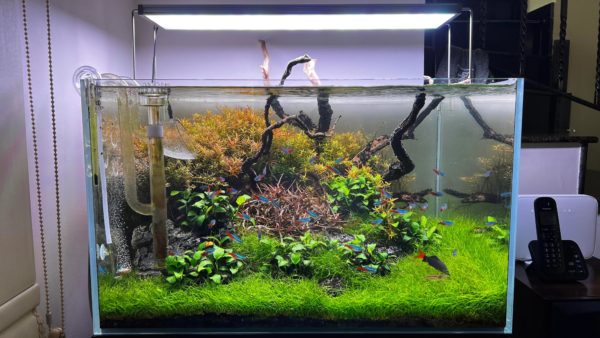
Furthermore, it’s better not to keep the tank in which this plant is kept in direct sunlight, as this could harm it. We advise you to use artificial aquarium lighting rather than relying solely on natural sunshine.
Nitrogen/Other Nutrient Requirements for Proserpinaca Palustris Tank?
Nutrient supplements are an excellent approach to ensuring that your plants get all their nutrients. These nutrients aren’t always necessary, but if your mermaid weed shows indications of being sick or weak, give it a boost with CO2 injections.
There is no necessity to add fertilizer in this case. This is because adding CO2 to your mermaid weed will speed up its growth rate, which will be beneficial for propagation and retain vivid colors.
Plant Features
The plant is known to be a slow grower even in enhanced environments. With sufficient light and sufficient carbon dioxide supplementation, the plant has the tendency to exhibit deed orange-red color especially on its leaves.
In an environment with high nitrate levels, the plant is said to condition the plant to exhibit light orange to fading green hues. Remember these colors are usually not pleasant if you are looking for something to make your aquarium look elegant and beautiful. The plant doesn’t grow too high and therefore is a great choice for aquarists who prefer shorter aquatic plant varieties.
Proserpinaca Palustris Compatibility and Tank Mates
You can mix Mermaid weed with other plant species to bring interest and vitality to your aquarium. Just make sure the plants aren’t too close together, or they’ll suffocate.
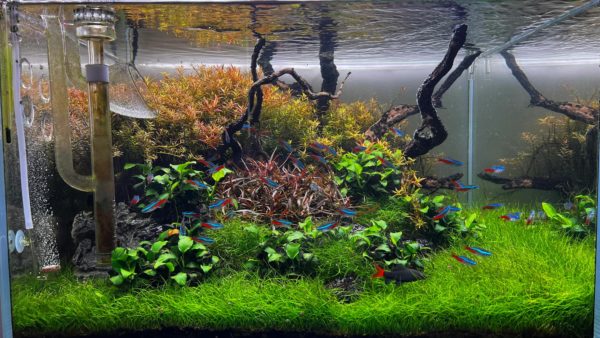
Ideal Proserpinaca Palustris Tank Mates
Make sure your Mermaid weed is in an aquarium with enough living things if you want it to be happy. Fish is a fantastic way to accomplish this. Fish usually use mermaid weed as a shelter or simply ignore it.
In any event, be aware that there are a variety of species that can harm your plants. Mermaid weed may withstand some light nibbling from fish, while Oscars would undoubtedly uproot and destroy it completely in no time.
Bad Tank Mates for Proserpinaca Palustris
Crayfish and crabs are also detrimental to the aquatic environment; hence they should not be kept in an aquarium with Mermaid weeds.
Growth Rate
This plant will thrive if given the correct conditions. It would attain 16 inches in height and 6 inches in width if it could grow as much as it wanted! It would undoubtedly take up your entire tank.
Nonetheless, trimming exists to limit the likelihood of mermaid weed overgrowth.
Pruning
Because mermaid weed can grow quite tall, you can simply give it more attention and trimming, as this is what will ultimately keep this small plant happy. Weed also grows slowly, so it won’t take over your tank as rapidly as other plants would, and you’ll have plenty of time to cut it.
Use in aquarium
Due to the slow growth rate of Proserpinaca Palustris it is usually used in small tanks where fast growing plants are not an option. It makes a great addition in the mid regions of the aquarium adding vibrant color hues there. Because it is known to take in nutrients from the water it is also a great choice of an aquarium plant to be used for water purification. Its finely arranged leaves really give out an outstanding look!
Facts About Proserpinaca Palustris
- Proserpinaca Palustris, often known as the Mermaid Weed, is a common aquatic plant found throughout the SouthEastern United States and South America.
- To help it grow, Proserpinaca Palustris should be planted in freshwater with fertilizer.
- It’s a good aquatic plant to have even if you’re new to the hobby because it adapts well to shifting conditions.
- Many people consider the plant among the most attractive freshwater aquarium plants because of its intricately designed leaves and vibrant colors.
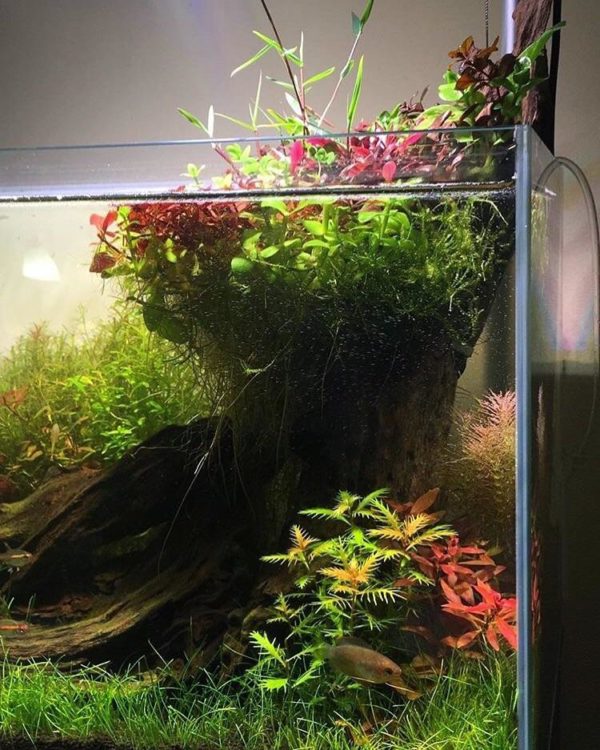
Are Proserpinaca Palustris Right for You?
Mermaid Weed, or Proserpinaca Palustris, is an excellent addition to any home aquarium or outdoor pond. These plants are striking in color and leaf shape, and they don’t require as much trimming as some aquarium plants.
Mermaid Weed is very easy to obtain, and because it is not an invasive species, you won’t have to worry about disposing of it as you would with some aquatic plants such as Guppy Grass.
Proserpinaca Palustris is not difficult to care for, although it is not suggested for complete beginners in the hobby.
Background or even midground placement is recommended.
It also serves as a hideaway for your fish and fries. There’s a good probability that this plant will be a good fit for everybody and that it will be simple to maintain. You should add Mermaid Weed to any paludarium, aquarium, or pond for a spectacular and wonderful display.
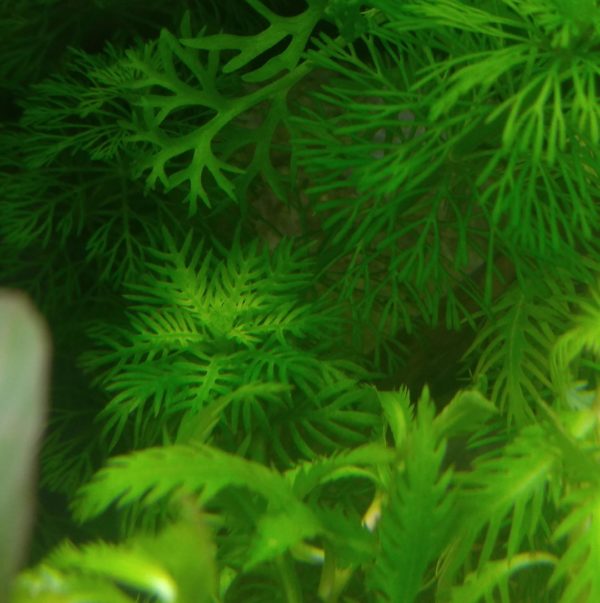
Proserpinaca Palustris is not difficult to grow or cultivate, although it takes a long time to mature from its emersed to submerged state. Its leaves are made up of two or more separate leaflets with simple lobes grouped one after the other along the stem, one leaf per node. You can find lobes and teeth on the edges of their leaf blade.
The Proserpinaca can produce symmetrically divided flowers. Each flower contains three petals, sepals, or tepals, which can form a cup or tube when joined together. It can also yield fruits with a size of 2 to 5 millimeters that are dry and don’t break open even when fully ripe.
Reasons Why Proserpinaca Palustris Is a Fantastic Aquarium or Pond Plant
The Proserpinaca Palustris became a favorite aquarium plant for numerous hobby aquarists due to its stunning color and eye-catching attractiveness. Mermaid Weed is a great choice if you have a tiny tank because it doesn’t grow too tall or quickly.
The Marsh Mermaid Weed’s attraction originates from the way it develops. It can develop from brilliant green leaves with rough edges to become a beautiful focal point with pink, almost golden-colored bristle-like leaves that will astound everyone.
The Proserpinaca Palustris’ vibrant red-orange tint and feather-like leaves provide an appealing value when put in your aquarium’s foreground or middle ground. The delicate leaf structure and vibrant hue may add a splash of distinctive beauty and color to your tank, sure to impress visitors.
The Proserpinaca, with its red, almost copper tint, can create a nice contrast to the other aquarium plants while also providing superb background covering if you’re going for a Dutch-themed aquascape.
This water plant appears stunningly esthetic; it also has health benefits. It can develop as an oxygenating pond plant buried in water, absorbing its nutrients, or as an emergent bog plant sprouting above water and receiving its nutrients. Because it feeds on water, it helps keep it clean by assisting in algae removal.
Mermaid Weed can be a fantastic source of nutrients for developing tadpoles when planted in the pond. This is something that tadpoles can eat to help them metamorphose faster in the pond. Small fish use this stem plant as a hiding place when submerged.
Purchasing Mermaid Weed
You should always confirm before buying any plant that it is healthy to prevent purchasing a sick plant. Look for evidence of wear and tear, such as fading colors or even damaged leaves, and don’t be fooled by anyone who claims their item is in great condition.
The Mermaid weed is also inexpensive. For $5, you can get a lot of stems, and if you want a bunch of this species, you can reproduce it at home, but it will take some time.
Propagate Mermaid Weed
The process of growing Mermaid weed is simple. Through assistance, you can help them to develop faster and more resiliently.
Mermaid weed generates side branches with roots and leaves, which eventually separate and form a new plant. Over time, the plant’s branches develop their leaves and roots, which eventually separate from them to form two whole plants.
Once the leaves have matured, and the side shoots are a few inches long, it’s time to replant them in a different region of your tank.
Faqs
Is It Possible to Eat Marsh Mermaid Weed? Will Fish Eat It?
Although marsh mermaid weed is safe to eat, most pond fish don’t find it particularly appealing. Some people claim that their goldfish bite it, although not enough to harm them. If your fish eat it, you can rest assured that you’ll not harm them. If your fish are very fond of this plant and are depleting the population, you may easily obtain more by trimming an inch or 2 off the top of the plant and planting it in the substrate.
What Is the Best Way to Care for A Mermaid Weed?
Mermaid Weed prefers to shed its leaves if kept under inadequate lighting and water-deficient in nutrients. For this plant to properly thrive, carbon dioxide infusion is strongly suggested. Mermaid Weed blooms at a medium to slow rate; thus, trimming isn’t required all that frequently.
What Is the Best Way to Plant Proserpinaca Palustris?
To help it grow, Proserpinaca Palustris should be planted in freshwater with fertilizer. It thrives in light conditions that range from medium to bright. The plant will take on its unique color under these lighting conditions.
Conclusion
When it relates to Mermaid weed care, the most critical factor is light. Give it ample bright indirect water and sunlight regularly if you want a lush and robust plant that will flourish year after year. When caring for this plant, other considerations include:
- Mermaid weed may grow in temperatures ranging from 50 to 82 degrees Fahrenheit.
- It thrives in a pH range of 5.0 to 7.5.
- CO2 inputs increase the pace of Mermaid weed growth.
- It can only grow in a sandy environment.
- Mermaid weed, despite its slow growth, necessitates constant trimming.
Because of its diverse growing locations, Proserpinaca Palustris has evolved into a plant with many variations with modest to major variances. The Cuban Proserpinaca Palustris, for instance, looks nothing like the Marsh Mermaid Weed we’re familiar with.
Proserpinaca Palustris is a good aquarium plant that native to the Eastern seaboard of the USA, the South Eastern region of the USA, a number of the Caribbean Islands as well as parts of South America. The plant is known to inhabit freshwater ponds, small river banks, and related wetlands. It is a favorite amongst small aquarium owners for its slow growth rate and relatively short height.
No related posts.
